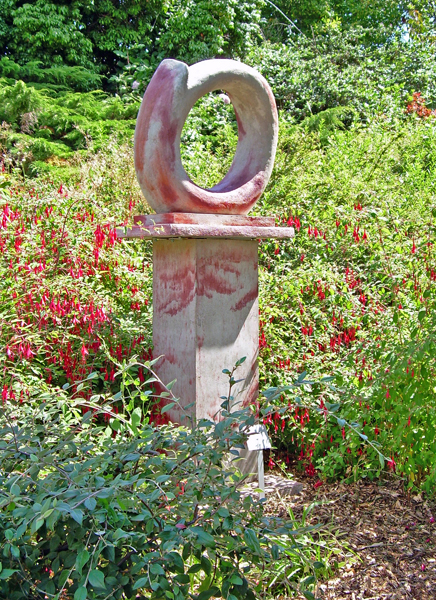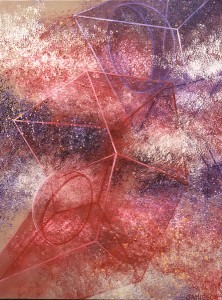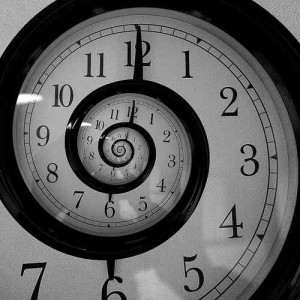On Abstract Art
I have always had a conflicted relationship with abstract art. On the one hand, I love the freedom of simply creating a visual language of form, colour and line to create a composition independent of the “real” world. On the other hand, I wonder whether it isn’t just a safe way to create artwork that won’t alienate anyone by saying anything about the “real” world.

Some suggest that the preference of the arts establishment for abstract rather than representational art sprang from the uproar associated with a mural done by Diego Rivera. A program called The Rockefellers shown on PBS’s “American Experience” describes Rivera’s confrontation with the American oligarchy and its sad implications for freedom of visual expression.
Rivera was an artist with strong political convictions that were not satisfied by abstract art. Drawn by the social movements unleashed by the Mexican Revolution, Rivera returned to his homeland in 1921 where he developed a unique style that combined the influences of European art and Mexico’s distinctive pre-Columbian iconography. In his populist murals, he used vibrant colors and simple scenes to illustrate his Marxist ideals and the plight of the working class throughout Mexican history. In 1922 his revolutionary convictions led him to join the Communist Party.
In 1932 Rivera traveled to the US where the culmination of the trip was to be a large mural for the centerpiece of the most talked about architectural project in the country —- the new Rockefeller Center. Rivera’s visit to the U.S. unfolded against the backdrop of the Great Depression and the intense social and political forces it had unleashed. Rivera’s mural Man at the Crossroads, begun in 1933, would feature two opposing views of society, with capitalism on one side and socialism on the other. While still in process, a furor erupted over a portrait of Vladimir Lenin included in the mural. As an outspoken leftist, the Mexican painter had tapped into the ruling elite’s growing concerns over the upsurge of Radicalism and growth of the Communist Party. The mural was removed, hammered off the walls and all evidence of it destroyed. As a result of the negative publicity, a further commission was cancelled to for Rivera to paint a mural for an exhibition at the Chicago World’s Fair.

The Tim Robbins film The Cradle Will Rock (1999) is a true story of politics and art in the 1930s USA, centered around a leftist musical drama and attempts to stop its production. Written & directed by Tim Robbin, it includes a dramatization of the confrontation between Rivera and New York’s elites set in the context of a general repression of the arts during the mid-1930’s using anti-communism as a rationale. The film suggested that this was the turning point in the history of modern art in which the political, media, financial & industrial ruling class made a conscious decision to actively promote abstraction as a politically neutral, non-threatening art form. Abstract art is safe art in that no contentious political issues are raised such that anyone could notice. Not that tempests-in-teacups haven’t raged over abstract art. I remember the kerfuffle that took place in Canada in the ’60’s when the National Gallery paid a million dollars or so for a giant blue canvas with a yellow stripe. But this is the kind of issue that politicians love – where the public attacks some small vulnerable minority like artists, rather than questioning the governing party’s self-serving policies. So though it is fun to play with forms, colours, lines & ideas in abstract ways, I wrestle with the frivolity of it. This, of course, drags forth the whole question of the meaning and purpose of art.
For many years I worked on the Running Man theme, described in an earlier blog, as a vehicle for expressing a strongly-felt philosophical perspective using a representational image that was abstracted so as to be widely applicable. When Running Man had run his course, I experimented with the purely visual universality of abstract painting while remaining wary of the empty pitfalls of decorative art. Below are a few examples of works from a series called Ephemera. These were studies for future sculptures in sheet acrylic and were depicted as though constructed from highly coloured transparent sheets of two-dimensional plastic.

Later works have carried the investigation into the possibility of creating these forms in three dimensions and in the more durable medium of concrete. Drawings and paintings in this series suggest the use of pigments in the resulting sculptures to investigate the potential for using colour to create a painterly surface.

These later works were done during the symposium where I created the steel & resin Running Man piece and was intrigued by the many excellent abstract sculptures being produced. I was living in a cabin beside an organic orchard just outside Kelowna BC and when not working on my commissioned piece, I cranked up Glenn Gould and played with oil pastels & coloured paper. The result was a series of drawings that were an adventure in line & colour.

My compass was my own inner sense of direction and a sense of excitement in the work. I used an unrestricted palette and exuberant scribbles in these drawings, eschewing precision in favour of freedom.


When exhibiting these drawings and the later paintings that grew out of them, I rationalized that I was exploring such metaphysical ideas as the relationship between the mind and body; time and space; the physical and the spiritual, because the real world demands an explanation. But really I was just having fun. I used these drawings as a basis for a series of oil paintings I called 2D/3D.


Again the motivation behind these drawings and paintings was play as opposed to consciously working toward the expression of some profound meaning. Having said that, the very act of drawing & painting has it’s own profundity. The daily pursuit of the elusive goal of expressing ideas visually provides direction in the same way that a religious discipline or philosophical framework provides meaning.

This is not a far-fetched analogy because the creation of visual art demands in-the-moment presence that is otherwise sought in meditation and other disciplines associated with religious practice. The act of drawing & painting can produce a sense of joy in the same way that meditation does in the devoted practitioner. That joy comes from overriding the over-busy mind and being present in the moment. And to be in the moment, all other worries, problems, desires and ambitions are put aside to listen to the artwork speak (or not) and be tuned to what needs to be done in order to bring it to life.More on this topic later in this post.
As with most of my paintings, I keep re-working them as long as they are available so Cross Purpose #1 was re-painted. In order to move away from the work as a painting and make it more of a sculpture study, Cross Purpose #2 was born as shown below.

There is a tension between paining qua painting and painting as a study for something else. Sculpture has to exist in 3 dimensions – to withstand gravity and all the slings & arrows that sculpture is heir to, so a sculpture study has to make sense as though it existed in the real world. The freedom to allow surfaces to appear & disappear without explanation is lost.
In the Fall of 2002, I began creating abstract sculptures in concrete based on the vocabulary of forms developed through the foregoing drawings & paintings. If pressed to explain the series , I would say it was an experiment in combining feminine and masculine energies, hard and soft lines, curves and angles, balance and imbalance, lightness and weight. To wax even more wordy, I would say they explore paradoxical states of being, the resolution of differences and the melding of opposites.
Below are a few examples:




The piece to the left, Conundrum, is one of the few sculptures for which I documented the process. The following images show the piece in progress.

First as shown on the right, an armature was carved out of found scrap high density polystyrene using a hot wire and saws. More about hot wire cutting is discussed in an earlier blog and more in another earlier blog. What isn’t shown is the next stage where this polystyrene armature was entirely covered with expandable wire mesh (stucco wire) which provides a surface for the concrete to grab onto. Also not shown was the rebar that was attached with this wire to strengthen the top arch.
Then the concrete was added as shown below.

The concrete used is a mix of 1:3 cement/ sand with liquid added to make it just wet enough to stick. The water is a 1:3 glue/water mixture to add strength. Later I added fibers for more strength. With the gravity-defying surfaces that need to be covered in a sculpture (ie overhangs etc.) the concrete can’t be heavy. It is hand applied, built up in layers, with each layer kept moist to allow the next layer to adhere. I would mix small amounts of concrete at a time (maybe 4-5 litres max) so that the concrete wouldn’t dry out but would last for 3-4 hours of work. It’s slow, careful work, not like pouring a pad all in one go.

The last few layers of concrete incorporated iron oxide pigments, as shown in the final image. Apparently this pigment is not good for you, so I wear thicker gloves for this portion of the work. Normally, I wear thin latex gloves to have maximum manual control.
I intensely pigmented small amounts of concrete then added them somewhat randomly to create a marbled effect. I really enjoyed the serendipidous patterns that were created – like painting with concrete in 3D. The inspiration for this approach were ancient stones in the Mayan ruins in the Yucatan peninsula. They effects of time on the stones had created beautiful patterns and colours.
I haven’t returned to purely abstract forms since 2005. After that I created abstracted representational forms as discussed in blogs 1-5. But the pull of simply working with pure form, colour & line is always there and I am currently working on a series of purely abstract paintings with no recognizable images to be seen. The debate in my head continues however, the main points of which are outlines in the next section.
Abstract Expressionism: Fashion and Art
The other night I went to see the play Red at the Vancouver Playhouse Theater. What a delight to see such great acting, dialogue, direction, & sets. Classical theater such as this is somewhat scarce these days in Vancouver as performance space is increasingly devoted to “multi-media performance”. Directors & choreographers feel obliged to throw in video, photography, sound (as opposed to music), and as much new media as possible in order to appear contemporary & relevant to the Tweet generation. Not that Red didn’t use video & stills, but they were used in such a way that they didn’t clutter up the play unnecessarily.
The play, taking place about 1968, foreshadows artist Mark Rothko’s suicide in 1970. The visual metaphor is that of the colour black, symbolizing death & destruction, gradually engulfs the colour red, symbolizing life in all its beauty & horror.

The play suggests that much of Rothko’s mental anguish was caused by his feeling of growing irrelevance as the art fashion of the day moved to Pop Art as defined by such artists as Roy Lichtenstein

Artists who follow their inner direction and volition with luck can find themselves on the crest of the latest fashion in art. Then when the tide turns and brings the next wave of young artists influenced by a new set of circumstances the formerly fashionable artists are left high & dry. As the critic Harold Rosenberg said, Rothko and his contemporaries tore down “…unlimited formal experimentation and parody and fragments of radical ideas” only to have their own ideas derided as egotistical and outdated by the next generation of artists.
The following is a quote that I wrote down without noting the source.” The rhetoric of isms and counter-isms has vexed the art world since the Second World War with new stylistic trends set up every few years to oppose whatever has become fashionable (postmodern succeeding modern, deconstruction succeeding that, and so on). The superficial theoretical pretensions of the various after-modern “schools” use cheap pronouncements cribbed from works of philosophy or literary theory. Art enjoys an oedipal energy in which creation is always destruction, usually of one’s most intimate influences.”
This Oedipal energy may not be as integral to art as it is to the culture of consumption. We are constantly reminded that we must have the newest, best and most cutting-edge of everything from electronics to hairdos to art. God forefend that we should have last-year’s version of anything. More profoundly, this is a belief that we are moving ever-forward on a trajectory of constant improvement. In this view, we are ever-striving onward & upward toward social & individual perfectability in which all wrong thinking & wrong acting will be eradicated. So the clunky cars of the 50,s, the horrendous politics of the 40’s, the economic errors of the ’20’s the stultifying social mores of the 1900’s and all the ignorance and pestilence that went before is being left ever-further behind us. And the more recent & contemporary the art movement, the more likely it is to be closer to the goal of full understanding and intelligence. It’s a view solidly ensnared in a belief that time’s arrow moves in only one direction -forward into the future.

Recent thinking is that time moves not only forward but also sideways (backwards is disputed). We are programmed (no doubt for our own sanity) to only perceive the forward motion of time, but it’s sideways mobility accounts for the frequently reported non-linear temporal events. This has implications for our attitude toward not only art but all human creative activities throughout time.


Abstract Expressionism: Meaning & Art
An excellent website called Art History Unstuffed provides a meaty discussion of Abstract Expressionism. In the section called How Abstract Expressionism Re-Defined Painting and Art: Abstract Expressionism and Meaning, the author Dr. Jeanne S. M. Willette states that “The Abstract Expressionist artists translated “meaning” from subject matter to the broader and deeper intent of the word. For these artists, “meaning” had to be profound and transcendent so that art could rise above the rather minor role it played during the Thirties as handmaiden to politics.” She sums up her section of this discussion on Abstract Expressionism by saying:
“With Abstract Expression the primary moral act is the decision to paint, followed by the question of what to paint at the time of the end of painting. In a world that has experienced an all engulfing war and a horrifying holocaust and a brilliant blast of annihilating light, painting becomes a moral activity, one of the last possible ethical gestures. Abstract Expressionism was an art of pure idea, considered to be sublime, even transcendent and thus reconnected with the early Romantic tradition of landscape painting in America. Nineteenth century American painting had sough God in Nature, but in a universe that had be denaturalized and had been scourged of God, the only transcendence or saving grace was art itself, the last refuge of godliness.”
On the one hand, this assumption appears to be the epitome of hubris – the idea that we can attain spiritual transcendence by playing with colour & form is surely a delusion. And it surely betrays arrogance and massive ego to assume that the arduous discipline necessary to find God, as taught by the world’s major religions over thousands of years, can be cheerfully circumvented by picking up a paintbrush and going at it.
On the other hand, as Barnett Newman said, “The artist expresses in a work of art an aesthetic idea which is innovate and eternal.” This idea captures the essence of abstraction as the artist seeks to remove all vestiges of identification with a particular place & time and creates a work that is universal. In this there is definitely an element of spiritual transcendence and in this way, art (whether Romantic landscape or Abstract Expressionist) can act as a bridge between the spiritual and the worldly.

But to imagine that one artistic approach, such as Abstract Expressionism, can replace the search for spiritual enlightenment is highly suspect, especially since some of its most famous practitioners found more solace in the bottle than in their work. And to imagine that we can replace God with Art is like assuming we can replace food with a cookbook.
Art, like yoga, prayer and other disciplines can lead toward spirituality, but surely the guidance of tried & true religious practices is needed. Art alone is too amorphous.

